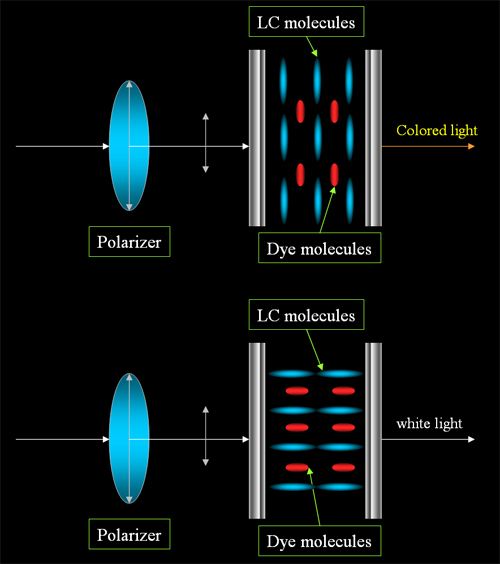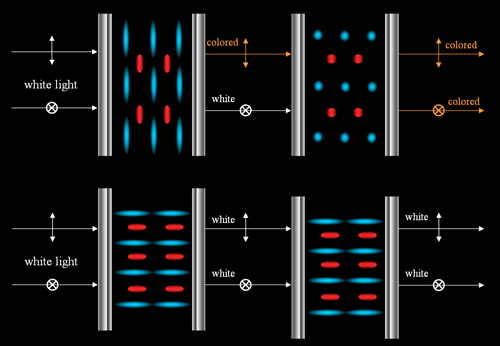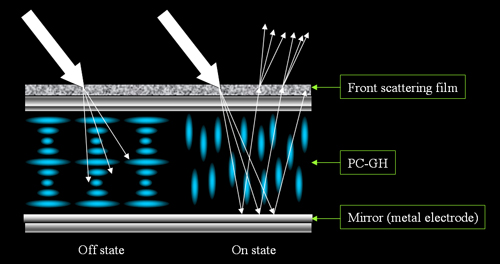¡¡[Guest - Host (GH) mode]
In a Guest - Host system, the mixture is
prepared by mixing LC and dichroic dyes. The dichroic dyes absorb
the light whose E-field is along the long axis of the dye, while the
negative dichroic dye absorb light whose E-field is perpendicular to
the long axis of the dye. When the LC molecules change their
orientation, the dye will also change along with LC molecules,
consequently, the absorption axis is changing, a light transmission
can be modulated.
There are three simple GH displays, which are
Heilmeier type GH, the Double Layer type GH and the PDLC type GH.
Heilmeier type GH display is shown in figure
1
below,
it utilizes one polarizer. In the off state (upper half), a polarized white light
after the polarizer is absorbed by the pleochroic dye, but not the
whole spectrum, hence the remaining spectrum exits the cell as
colored image. In the on state (lower half), light passes through the cell with
very small attenuation from the dye, hence a white image is
obtained.

Figure 1. The Heilmeimer
Guest-Host display.
Double GH
devices use two orthogonally aligned GH cells which attenuate both
directions of incident lights as shown in figure 2. In the off state, the director and
dye align parallel to the surface alignment layer, therefore, two
directions of polarized lights are absorbed. In the on state, both
the director and the dye align perpendicular to the surface,
therefore, the light can pass through. Since no polarizers are
needed, high brightness is
achieved. LC materials with ¦¤¦Å<0 can also be used, in this case, the
on and off states are just the opposites to the case of LC materials
with ¦¤¦Å>0.

Figure 2. Double Guest-Host
display.
A PDLC GH utilize the light scattering caused by
index mismatching to modulate the light transmission.
Another important
GH mode is the phase change GH (PC-GH), which is named
after the inventors, White-Taylor GH display. In the off state, the
dye is in the cholesteric LC, and the helix axis of ChLC can be
parallel or perpendicular to the surface, in both cases, the dye in
oriented in all directions due to rotating directors. When the light
passes through, only a small spectrum remains, hence a color image
is obtained. In the on state, minimum absorption is present, hence a
white image is obtained. The PC-GH does not allow grey scale because
of the hysterisis in the transmission-voltage curve. The response
time of PC-GH is slower than the conventional nematic display
because the viscosity increases from the doping of the dyes. The
viewing angle is very good, with a 900 cone of contrast
ratio 10:1.

Figure 3. A
White-Taylor GH-display with ¦¤¦Å>0 LC.
The GH display have found more applications in
reflective type display than transmissive type. The following figure
shows a scheme of PC-GH-reflective display.

Figure 4. A reflective
black and white PC-GH display.
Further Readings
and References:
G.H. Heilmeier and L.A. Zanoni, ¡°Guest-host
interactions in nematic liquid crystals. A new electrooptic effect,¡±
Appl. Phys. Lett. vol. 13, 91 (1968).
Uchida et al., "Bright Dichroic Guest-Host
LCDs Without a Polarizer," Proceedings of the SID, vol. 22/1, 41
(1981).
DL White and GN Taylor, ¡°New absorptive mode
reflective liquid. crystal display device,¡± J. Appl. Phys., vol. 45,
4718 (1974)
¡¡